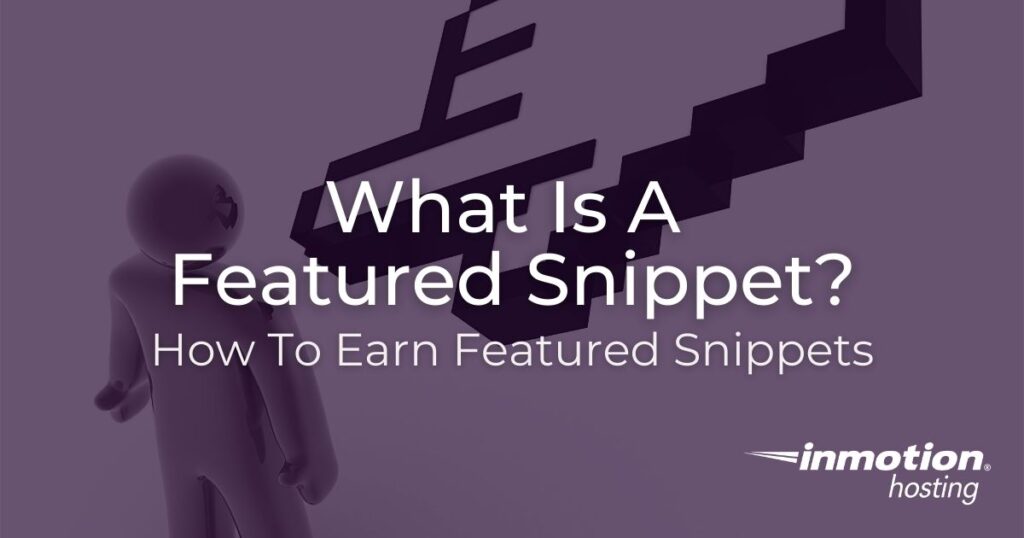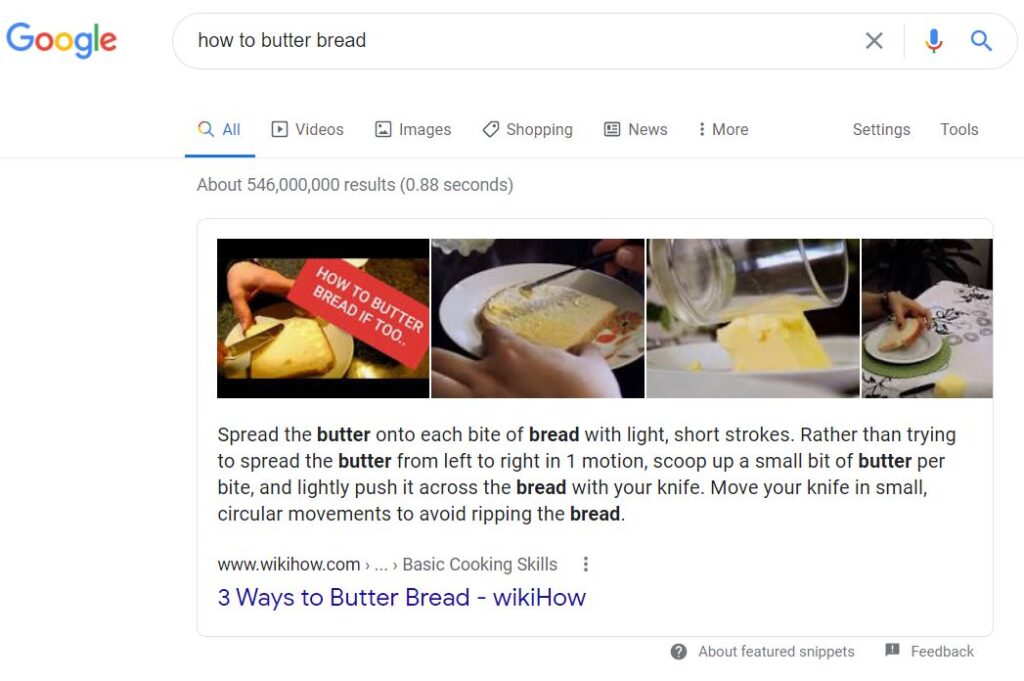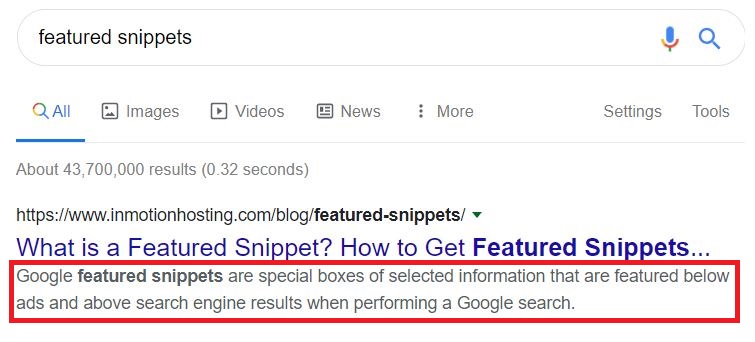
Google featured snippets are special boxes of selected information that are featured below ads and above search engine results when performing a Google search.
This information provides one definitive answer that Google believes to be the best fit for a specific question or query.
In this article we will break down exactly what featured snippets are, how they are chosen, and how you can use this information to increase your chances of being selected for featured snippets.
- What is a Featured Snippet?
- Why Do Featured Snippets Matter?
- How Are Google Featured Snippets Chosen?
- How to Get a Featured Snippet
What is a Featured Snippet?
Unlike organic search results that display popular web pages and whatever content that site used for its meta description, featured snippets are special boxes where the format of a regular search result is reversed, showing the descriptive snippet first.
The goal of featured snippets is to make it quicker and easier for searchers to find the information they are looking for.
Google chooses to display a featured snippet when their systems determine the snippet format would help people more easily discover what they’re seeking.

The information contains what Google believes the searcher is hoping to learn from both the description about the page and when they click on the link to read the page itself.
Featured snippets usually display just one listing, but at times there may be multiple snippets. They’re especially helpful for users on mobile devices or searching by voice.
Why Do Featured Snippets Matter?
The short answer to why featured snippets matter is they are fantastic for SEO. Landing a featured snippet is a great chance to increase your brand awareness, drive traffic to your website, and boost revenue and sales.
While showing up first in organic search results is amazing, it’s also extremely hard to do.
Depending on what you are writing about, there could be thousands or even millions of websites competing for the same keyword or keywords. The more people writing about a topic means more people you have to battle to climb to the top of the search engine result pages (SERPs).
Not only that but as we discussed above, featured snippets are shown before the first-ranked page. That means if you can get your content into a featured snippet, it should be seen by more eyes than even the top-ranked webpage.
Once a user clicks a featured snippet, they are taken directly to the section of the page that appeared in the featured snippet. Scrolling to the position that appeared in the snippet happens automatically without any additional adjustments by the site.
How Are Google Featured Snippets Chosen?
Featured snippets are pulled from web search listings, and are chosen automatically.
Google’s automated systems determine whether a page would make a good featured snippet to highlight for a specific search request. If the system deems that a page would me a good featured snippet for that specific request, it elevates it automatically.
Although you can not select your page for a featured snippet, there are two ways site owners are able to suggest their content for the featured snippets Google creates: rich results and meta description tags.
- Rich results: Add structured data to your site to help Google understand the page such as a review, recipe, business, or event.
- Meta description tags: Google sometimes uses <meta> tag content to generate snippets if it thinks the meta tags use a more accurate description than can be learned directly from the page content.
Whether or not Google chooses to use your content for a feature snippet is entirely up to them, but there are several best practices you can employ to give your content the best possible chance and being chosen.
How to Get a Featured Snippet
A commonly searched question on Google is “how to get a featured snippet?” Ironically, there is no featured snippet for that specific search request.
Why is that? Because there’s not a clean and simple answer.
Much like earning the top result in the SERPs, getting chosen for featured snippets likely means the author of the content put in a good amount of effort or used a very targeted strategy to earn their spot there.
With that in mind, here are the best practices you can incorporate into your content to improve its chances of being chosen for a featured snippet.
Create Descriptive Page Titles
Good page titles are essential to giving users some quick insight into the content of a result and why it’s relevant to their query.
They are often the first thing users notice and the primary piece of information they take into account when deciding which result to click on. That means high-quality page titles should be a top priority for your content.
Below are some tips for creating great page titles:
- Be descriptive and concise: Page titles should be short and to the point. Avoid using vague or filler words. If a title is too long, it will be truncated and the full title will not be displayed in the search results.
- Use title tags: Every single page on your website should have a title specified in the <title> tag.
- Avoid keyword stuffing: Keyword stuffing not only increases your chances of cannibalizing your own keywords, but it also makes your content look spammy to Google.
- No repeated or boilerplate titles: Every page needs to have distinct, descriptive titles. Avoid repeating titles or using titles designed to draw readers into a page without directly answering their question. Similarly, avoid standardized titles that use a consistent format with lots of text irrelevant to the content of the page.
- Allow crawling: If you decide to disallow search engines from crawling your pages, there’s almost no chance Google will select your content for a featured snippet.
- Brand titles only where necessary: Using your brand name on page titles like your homepage and other pages it makes sense to do so is fine, but don’t overdo it. Branding all your page titles hurts readability and decreases your chances of earning a featured snippet.
Create Good Meta Descriptions
When generating featured snippets, there are times Google will use the <meta> description tag if its system believes the metadata gives users a more accurate description than would be possible purely from the on-page content.
Every single page on your website should have a meta description.

In general, meta description tags should inform and interest users with a concise, relevant summary of what a particular page is about. Think of meta descriptions as the pitch you are using to convince the user that your page is exactly what they’re looking for.
Here are some other helpful tips for writing great meta descriptions:
- Avoid being repetitive: Make sure every page has a unique meta description and provides information that is actually useful to those searching.
- Include clearly-tagged facts: Listing things like the author, byline, or publication date can give potential visitors very relevant information that might not be displayed in the snippet otherwise.
- Programmatically generate descriptions: If you run a database-driven site, like a product aggregator, hand-written descriptions could be impossible. That is where using programmatic generation for descriptions can help. Good descriptions are human-readable and diverse. Page-specific data is a good candidate for programmatic generation. Meta descriptions composed of long strings of keywords that don’t give users a clear idea of the page’s content are less likely to be displayed in place of a regular snippet.
- Focus on high-quality descriptions: Last but certainly not least, make sure your descriptions are actually descriptive. High-quality descriptions can earn you a spot in Google’s search results or potentially even a featured snippet.
For more information on what Google wants to see in your page titles and meta descriptions, check out Create good titles and snippets in Search Results.
As we covered above, there is no concrete way to ensure your content lands in featured snippets, and even using best practices doesn’t guarantee your page will be chosen.
However, best practices do greatly improve your chances of earning a coveted featured snippet, and each featured snippet you earn can lead to a massive boost in traffic and revenue.
Like a lot of SEO results, earning featured snippets likely won’t happen overnight. But with some dedication, effort and patience, those results will eventually come if you follow the tips outlined above.
If you want to land featured snippets and you’re considering updating your old content but aren’t sold yet, check out Why Updating Content is a Great SEO Content Writing Strategy.
For even more information on featured snippets, check out featured snippets and your website.
If you need a new home for your WordPress site, look no further than InMotion’s WordPress Hosting solutions for secure, optimized, budget-friendly servers.
Fast & Easy Transfers
Free SSLs
Hack Protection
Affordable